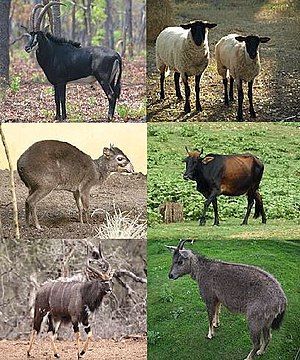소과
|
| ||
|---|---|---|
 왼쪽 상단부터 시계 방향으로 검은영양, 양, 인도혹소, 중국고랄, 니알라영양, 맥스웰다이커. | ||
| 생물 분류ℹ️ | ||
| 계: | 동물계 | |
| 문: | 척삭동물문 | |
| 강: | 포유강 | |
| 목: | 우제목/경우제목 | |
| 과: | 소과 (Bovidae) Gray, 1821 | |
| 아과 및 족 | ||
| ||
소과(-科, 표준어: 솟과, Bovidae)는 우제목/경우제목(유제류)에 속하는 반추동물 포유류 과의 하나이다.[1] 소와 들소, 아프리카들소, 물소, 영양, 가젤, 양, 염소 등을 포함하여 10개 아과에 143종의 현존 종과 300여 종의 멸종 종을 포함하고 있다. 진화의 역사는 약 2천만년 전, 신생대 제3기 마이오세까지 거슬러 올라간다. 다리가 짧고 발굽이 둘로 나뉘며, 초식성이며 되새김질을 한다.
하위 분류[편집]
- 소아과 (Bovinae) - 10속 27종
- 다이커영양아과 (Cephalophinae) - 3속 19종
- 힙포트라구스아과 (Hippotraginae) - 3속 7종
- 영양아과 (Antilopinae) - 13속 34종
- 양아과 (Caprinae) - 10속 33종
- 리드벅아과 (Reduncinae) - 2속 9종
- 임팔라아과 (Aepycerotinae) - 1속 1종
- 임팔라속 (Aepyceros)
- 리복아과 (Peleinae) - 리복 1속 1종
- 리복속 (Pelea)
- 하테비스트아과 (Alcelaphinae) - 히롤라, 하테비스트, 누 등
- 티베트영양아과 (Pantholopinae) - 1속 1종
- 티베트영양속 (Pantholops)
계통 분류[편집]
다음은 2009년 스폴딩(Spaulding) 등의 연구에 기초한 계통 분류이다.[2]
| 우제목/경우제목 |
| |||||||||||||||||||||||||||||||||||||||||||||||||||||||||
다음은 2019년 주라노(Zurano) 등의 연구에 기초한 소과의 계통 분류이다.[3]
| 소과 |
| ||||||||||||||||||||||||||||||||||||||||||||||||||||||||||||||||||
각주[편집]
- ↑ Grubb, P. (2005). “FAMILY Bovidae”. Wilson, D.E.; Reeder, D.M. Mammal Species of the World: A Taxonomic and Geographic Reference (영어) 3판. 존스 홉킨스 대학교 출판사. ISBN 978-0-8018-8221-0. OCLC 62265494.
- ↑ Michelle Spaulding, Maureen A. O’Leary und John Gatesy: Relationships of Cetacea (Artiodactyla) Among Mammals: Increased Taxon Sampling Alters Interpretations of Key Fossils and Character Evolution. PlosOne 4 (9), 2009, S. e7062
- ↑ Juan P. Zurano, Felipe M. Magalhães, Ana E. Asato, Gabriel Silva, Claudio J. Bidau, Daniel O. Mesquita und Gabriel C. Costa: Cetartiodactyla: Updating a time-calibrated molecular phylogeny. Molecular Phylogenetics and Evolution 133, 2019, S. 256–262



